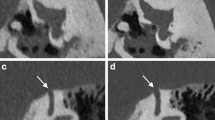Abstract
We assessed the value of MRI for delineation of dehiscence of the superior or posterior semicircular canal, as compared with CT, the current standard study for this entity. We reviewed heavily T2-weighted fast spin-echo images and high-resolution CT of the temporal bones of 185 patients independently semicircular canal dehiscence and its extent. In 30 patients (19 men, 11 women) we identified dehiscence of the bone over the superior and/or posterior semicircular canal on MRI. In 27 of these cases CT also showed circumscribed bone defects. In one patient dehiscence of the superior semicircular canal was initially overlooked on MRI, but seen on CT. MRI imaging thus had a sensitivity of 96% and specificity of 98%. Knowledge of the appearances of this entity on MRI may contribute to early diagnosis in patients with vertigo due to semicircular canal dehiscence.




Similar content being viewed by others
References
Minor LB, Solomon D, Zinreich JS, Zee DS (1998) Sound- and/ or pressure-induced vertigo due to bone dehiscence of the superior semicircular canal. Arch Otolaryngol Head Neck Surg 124: 249–258
Hirvonen TP, Carey JP, Liang CJ, Minor LB (2001) Superior canal dehiscence: mechanisms of pressure sensitivity in a chinchilla model. Arch Otolaryngol Head Neck Surg 127: 1331–1336
Brantberg K, Bergenius J, Tribukait A (1999) Vestibular-evoked myogenic potentials in patients with dehiscence of the superior semicircular canal. Acta Otolaryngol 119: 633–640
Brantberg K, Bergenius J, Mendel L, Witt H, Tribukait A, Ygge J (2001) Symptoms, findings and treatment in patients with dehiscence of the superior semicircular canal. Acta Otolaryngol 121: 68–75
Mong A, Loevner LA, Solomon D, Bigelow DC (1999) Sound- and pressure-induced vertigo associated with dehiscence of the roof of the superior semicircular canal. AJNR 20: 1973–1975
Casselman JW, Kuhweide R, Ampe W, Steyaert L (1993) Pathology of the membranous labyrinth: comparison of T1- and T2-weighted and gadolinium-enhanced spin-echo and 3DFT-CISS imaging. AJNR 14: 59–69
Czerny C, Rand T, Gstoettner W, Woelfl G, Imhof H, Trattnig S (1998) MR imaging of the inner ear and cerebellopontine angle: comparison of three-dimensional and two-dimensional sequences. Am J Roentgenol 170: 791–796
Schmalbrock P (2000) Comparison of three-dimensional fast spin echo and gradient echo sequences for high-resolution temporal bone imaging. J Magn Reson Imaging 12: 814–825
Krombach GA, Schmitz-Rode T, Tacke J, Glowinski A, Nolte-Ernsting CC, Günther RW (2000) MRI of the inner ear. Comparison of axial T2-weighted, three-dimensional turbo spin-echo images, maximum-intensity projections and volume rendering. Invest Radiol 35: 337–342
Klein HM, Bohndorf K, Hermes H, Schütz WF, Günther RW, Schlöndorff G (1992) Computed tomography and magnetic resonance imaging in the preoperative work-up for cochlear implantation. Eur J Radiol 15: 89–92
Fox EJ, Balkany TJ, Arenberg IK (1988) The Tullio phenomenon and perilymph fistula. Arch Otolaryngol Head Neck Surg 98: 88–89
Watson SR, Halmagyi GM, Colebatch JG (2000) Vestibular hypersensitivity to sound (Tullio phenomenon). Structural and functional assessment. Neurology 54: 722–728
Smullen JL, Andrist EC, Gianoli GJ (1999) Superior semicircular canal dehiscence: a new cause of vertigo. J Louisiana State Med Soc 151: 397–400
Minor LB (2000) Superior canal dehiscence syndrome. Am J Otol 21: 9–19
Carey JP, Minor LB, Nager GT (2000) Dehiscence or thinning of bone overlying the superior semicircular canal in a temporal bone survey. Arch Otolaryngol Head Neck Surg 126: 137–147
Author information
Authors and Affiliations
Corresponding author
Rights and permissions
About this article
Cite this article
Krombach, G.A., Schmitz-Rode, T., Haage, P. et al. Semicircular canal dehiscence: comparison of T2-weighted turbo spin-echo MRI and CT. Neuroradiology 46, 326–331 (2004). https://doi.org/10.1007/s00234-003-0948-6
Received:
Accepted:
Published:
Issue Date:
DOI: https://doi.org/10.1007/s00234-003-0948-6




